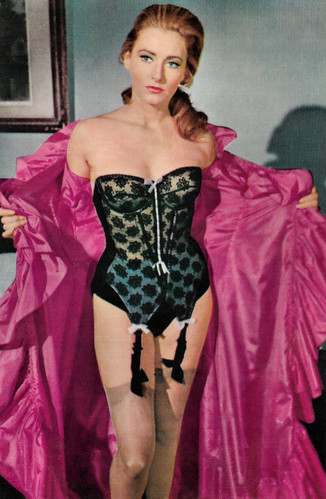
German postcard by Krüger, no. 902/91. Photo: Sam Lévin.

Italian postcard, no. 18. Elga Andersen in Coast of Skeletons (Robert Lynn, 1965).

French postcard by St. Anne, Marseille. Photo: Sam Lévin.

French postcard by Editions P.I., Paris, no. 1053. Photo: Sam Lévin.
Bohemian life
Elga Andersen was born Elga Hymen in Dortmund, Germany in 1935. She was the only child of a civil engineer. Two weeks before World War II ended, her parents had a quarrel so severe that her father left to join the Wehrmacht and was sent to the Russian front. He was never heard from again.
First Elga hoped to become a dancer but then studied French and English. To help support her mother, Elga quit school at 16 and worked for a while as an English and French interpreter. In 1953, the 18-year-old went to Paris, where she led a bohemian life, met artists and posed for fashion shoots for various European magazines.
She made her film debut when she was discovered by director André Hunebelle. She appeared in Les Collégiennes/The Twilight Girls (André Hunebelle, 1957) as Elga Hymen. The following year she appeared in a small role in Bonjour Tristesse (Otto Preminger, 1958) with Jean Seberg. It was Preminger who suggested she renamed herself Elga Andersen and as such, she continued to work steadily mostly in European films and television up to 1974. Next followed a part in the classic thriller Ascenseur pour l'échafaud/Elevator to the Scaffold (Louis Malle, 1958), starring Jeanne Moreau and Maurice Ronet.
She also appeared in German productions like Ist Mama nicht fabelhaft?/Isn't Mama Fabulous? (Peter Beauvais, 1958) and So ein Millionär hat's schwer/Such a Millionaire has Tough Times (Géza von Cziffra, 1958) starring Peter Alexander. Her first leading role was in the French-Brazilian adventure Os bandeirantes/The Pioneers (Marcel Camus, 1960).
Elga took singing lessons and performed the songs 'Treu sein' and 'Sündenlied' in The Guns of Navarrone (J. Lee Thompson, 1961). Gilbert Bécaud wrote especially for her 'Et maintenant', with words by Pierre Delanoë. In 1962, she wed her first husband, French architect Christian Girard in Paris, but the marriage ended in a divorce.

German postcard by Kunst und Bild, Berlin-Charlottenburg, no. A 1567. Photo: Hope / Gloria-Film / Niczky. Elga Andersen in Solang' die Sterne glüh'n/As long as the stars are glowing (Franz Antel, 1958).

German postcard by Krüger, no. 902/35. Publicity card for Philips to promote the single Flüstertango/Heut' dreh'n wir mal ein Ding, Marcel (1963) with Eddie Constantine and Elga Andersen.
Listen to Flüstertango (1963). Source: 45Vault (YouTube).

French postcard by E.D.U.G., no. 323. Photo: Sam Lévin.
Psychedelic sixties extravaganza
Elga Andersen appeared as a seductive beauty in many European films of the 1960s. Among them were the crime comedy Le Monocle Noir/The Black Monocle (Georges Lautner, 1961), and the sequel L'oeil du monocle/The Eye of the Monocle (Georges Lautner, 1962), both starring Paul Meurisse. She appeared opposite Eddie Constantine as Lemmy Caution in the comic thrillers L'empire de la nuit/The Empire of Night (Pierre Grimblat, 1962) and A Toi de Faire Mignonne/Your Turn, Darling (Bernard Borderie, 1963).
Other films were the comedy DM-Killer (Rolf Thiele, 1965) with Curd Jürgens, the Spaghetti Western Starblack (Giovanni Grimaldi, 1966), and the psychedelic sixties extravaganza La battaglia dei mods/The Battle of the Mods (Franco Montemurro, 1966) with Joachim Fuchsberger and singer Ricky Shayne. Andersen also appeared in such European films as the adventure Le Capitaine Singrid/Captain Singrid (Jean Leduc, 1967), Sex Power (Henry Charpin, 1970) with Jane Birkin, and the excellent comedy Detenuto in attesa di giudizio/Why? (Nanni Loy, 1971), starring Alberto Sordi.
Elga worked in a few Hollywood features too, credited as Helga Anderson, including A Global Affair (Jack Arnold, 1964) opposite Bob Hope. She is best known for portraying Lisa Belgetti, Steve McQueen's love interest in the racing epic Le Mans (Lee H. Katzin, 1971). Andersen and McQueen reportedly had an affair during the filming. One of the Porsche 911 T sports coupes used in the production was given to Andersen as partial compensation for her work in the film.
When promoting Le Mans for Cinema Center Films, she met American producer and millionaire Peter R. Gimbel who was promoting his documentary on great white sharks, Blue Water, White Death (Peter Gimbel, James Lipscomb, 1971), for the same firm. Gimbel, heir to the Gimbel Department Stores, and Andersen married in 1978 and the couple stayed together till his death in 1987. Her last film was Le Serpent/The Serpent (Henri Verneuil, 1973) starring Yul Brynner and Henry Fonda, and on TV she was last seen in the Sci-Fi series Aux frontières du possible/At the edge of the Possible (Victor Vicas, Claude Boissol, 1971-1974) with Pierre Vaneck.
Elga Andersen joined her husband on his various diving expeditions. In 1981 they tried to locate and salvage the bank safe of the sunken Italian ocean liner Andrea Doria. Andersen produced for TV the documentary Andrea Doria: The Final Chapter (Peter Gimbel, 1981) about this project that made many headlines. Elga Andersen died of cancer in 1994, in New York City, USA. She was only fifty-nine. Andersen was cremated and divers placed her ashes, along with those of her husband inside the sunken hull of the Andrea Doria during the following year.

Spanish postcard by Raker, no. 1.158, 1965.

French postcard by E.D.U.G., no. 87. Photo: Sam Lévin.

Yugoslavian postcard by Cik Razglednica.
Original trailer for Le Mans (Lee H. Katzin, 1971). Source: HD Retro Trailers (YouTube).
Sources: Sandra Brennan (AllMovie), Gioia Diliberto (People), Dan Scott (Find A Grave), Ray Young (Flickhead - now restricted), IMDb, and Wikipedia (German and English).
This post was last updated on 5 April 2023.
1 comment:
What a beauty. And a good reminder that I need to finally see Le mans.
Post a Comment